The Everest Base Camp Trek is a thrilling journey that attracts adventure enthusiasts from around the globe. Spanning across some of the highest altitudes in the world, this trek offers breathtaking views, cultural insights, and a sense of accomplishment. But to make the most of your trekking experience, it's crucial to plan your trip around the weather conditions and temperatures in the region.
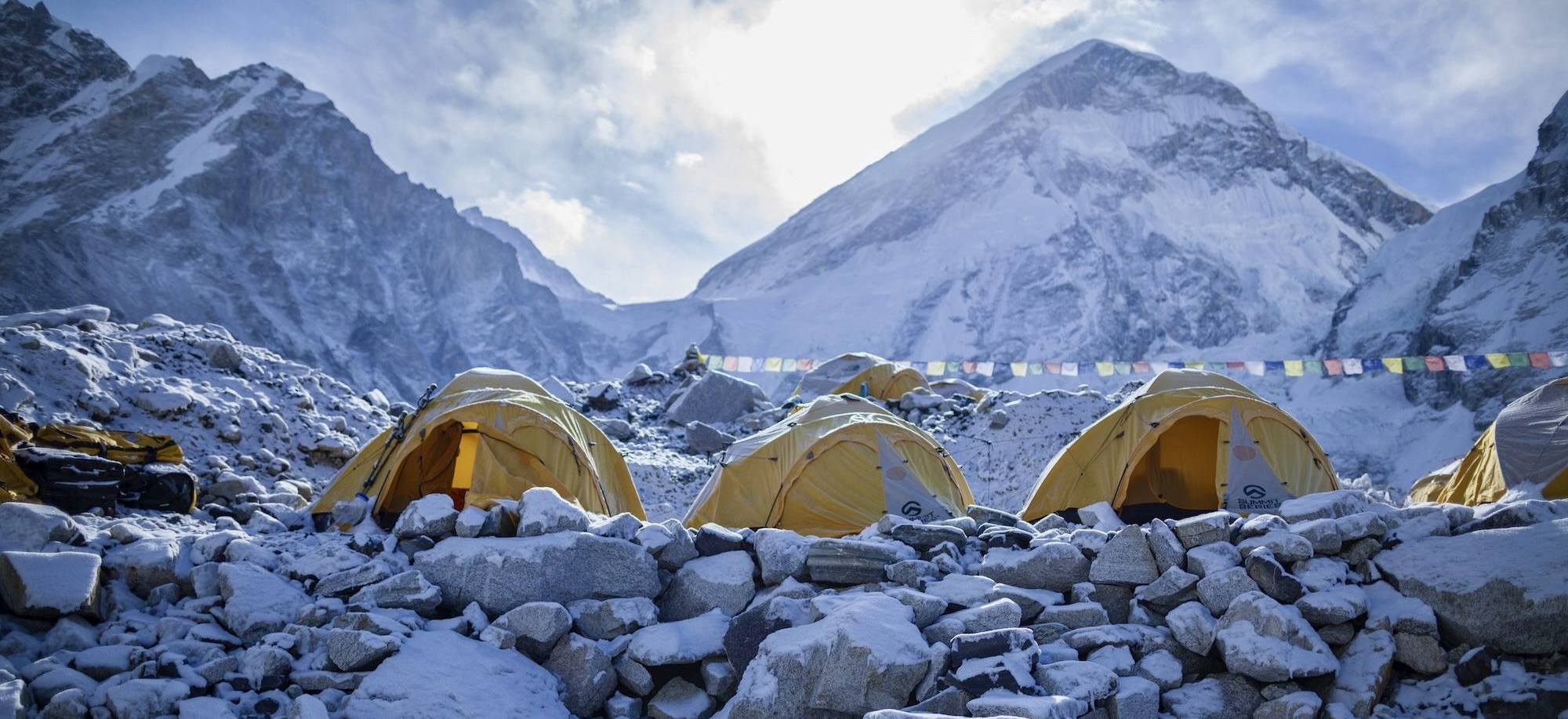
As the Everest Base Camp lies at an elevation of about 5,364 meters (17,598 feet), the weather can vary drastically depending on the time of the year. Therefore, understanding the monthly weather patterns and temperature fluctuations at Everest Base Camp can greatly enhance your trekking experience.
This guide provides a month-by-month breakdown of the weather and temperature during the Everest Base Camp Trek, helping you to choose the best time for your trek and what to expect during each season. From the crisp and clear days of autumn, the snow-filled paths of winter, the blossoming beauty of spring, to the lush green landscapes of monsoon, each month brings a unique flavor to this journey. Let's delve into the details and help you plan your trek efficiently.
January: The Coldest Month
January is considered the middle of winter in the Everest region, and it is indeed one of the coldest months. Day temperatures at lower elevations hover around 6°C (42.8°F), but they drop significantly as you gain altitude, and nights can be much colder. At the base camp itself, night-time temperatures can drop as low as -20°C (-4°F) or even lower.
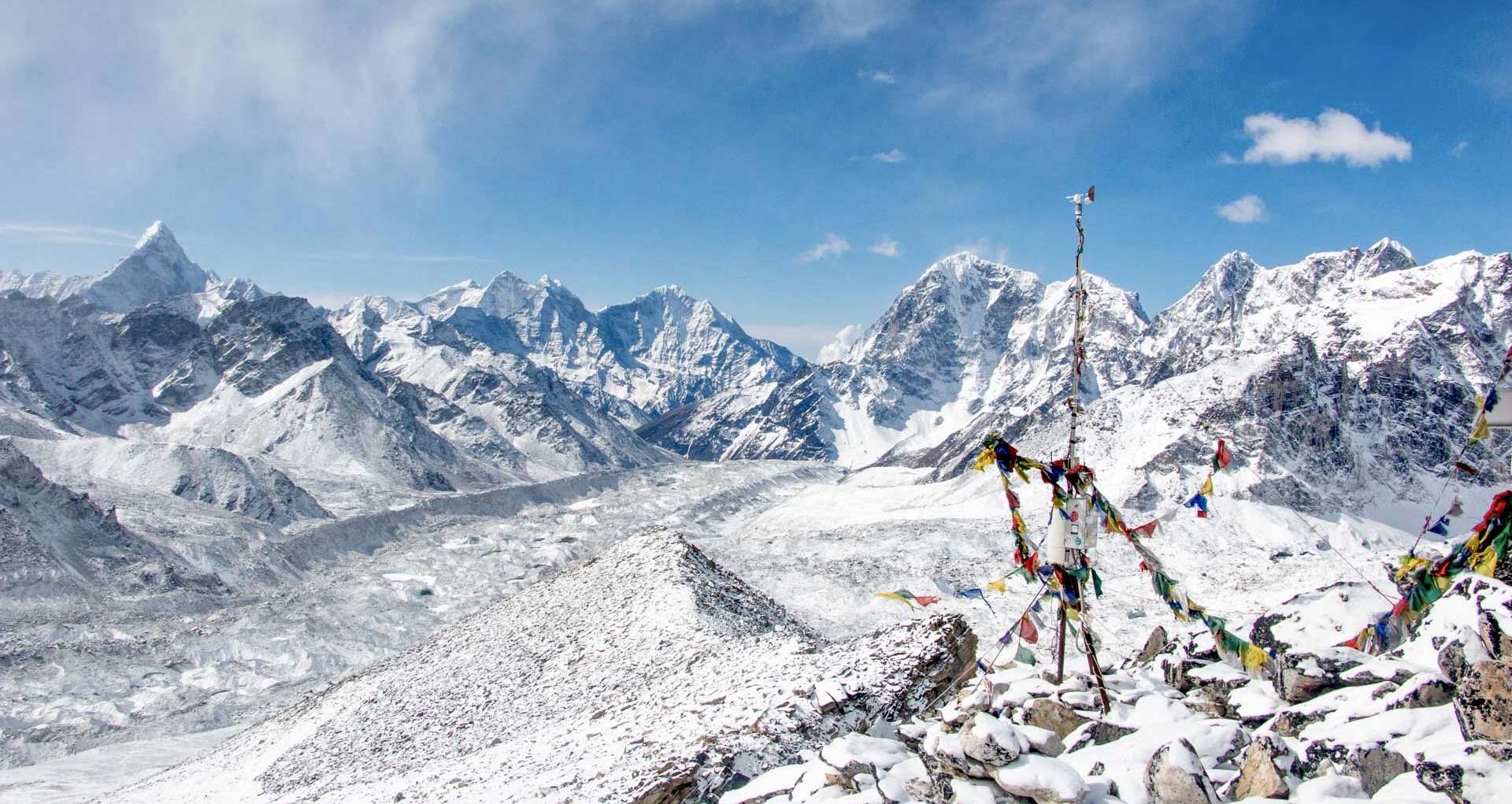
Snowfall is common, especially at higher elevations, which can lead to trail closures or diversions. However, on days when the skies are clear, which is often the case, the mountain views are nothing short of spectacular. The air is crisp and the visibility is excellent, providing some of the best mountain vistas you'll see all year.
Another advantage of trekking in January is the lack of crowds. Unlike the peak trekking seasons in the spring (March-May) and autumn (September-November), the trails are much less crowded in January. This means you'll often find yourself in solitude, surrounded by the quiet beauty of the Himalayas.
Moreover, tea houses and lodges along the trail are less likely to be fully booked, so finding accommodation is rarely an issue. Many tea houses offer rooms for free, expecting you to dine with them.
However, trekking in January does require a high level of preparation. It is essential to bring warm clothing and gear to protect against the severe cold, especially at night. Items like a good quality down jacket, thermal innerwear, warm gloves, and a hat are must-haves.
In conclusion, while January presents more challenging conditions, it can be a great time for experienced trekkers who are well-prepared and looking for a quieter, more solitary trekking experience.
February: The End of Winter
February marks the tail end of winter in the Everest region. Similar to January, the weather is cold, and snowfall is common, especially at higher altitudes. However, as the month progresses, the intensity of the cold starts to lessen gradually.
During the day, temperatures at lower altitudes can reach up to 8°C (46.4°F). At higher altitudes and at Everest Base Camp itself, the daytime temperatures can still be below freezing, and night-time temperatures can drop down to -15°C (5°F) or lower.
Like January, February is a quiet month on the trails. The winter solitude continues to offer trekkers the opportunity to enjoy the beauty of the Everest region without the crowds. The snow-capped landscape provides stunning views, and on clear days, you'll experience some breathtaking vistas of the Himalayas.
However, because February is still a winter month, it is essential to pack suitable clothing and equipment. Good quality warm clothing, thermal underwear, and good sleeping bags are necessary. Hiking boots with good grip are crucial as the trails can be slippery due to the snow.
Towards the end of February, the signs of spring start to appear, the snow begins to melt, and the rhododendrons start to bloom, adding a touch of color to the otherwise white landscape.
Despite the cold, February can be a great month for the Everest Base Camp trek if you're well-prepared and prefer a quieter trekking experience. Do note that winter trekking requires a higher level of experience and preparation compared to other times of the year.
March: The Start of Spring
March marks the onset of spring in the Everest region. The weather begins to warm up slightly compared to the freezing temperatures of winter. The average daytime temperature at the base camp during March can range from -2 to -8 degrees Celsius (28.4 to 17.6 degrees Fahrenheit). At night, temperatures can dip down to -12 degrees Celsius (10.4 degrees Fahrenheit).
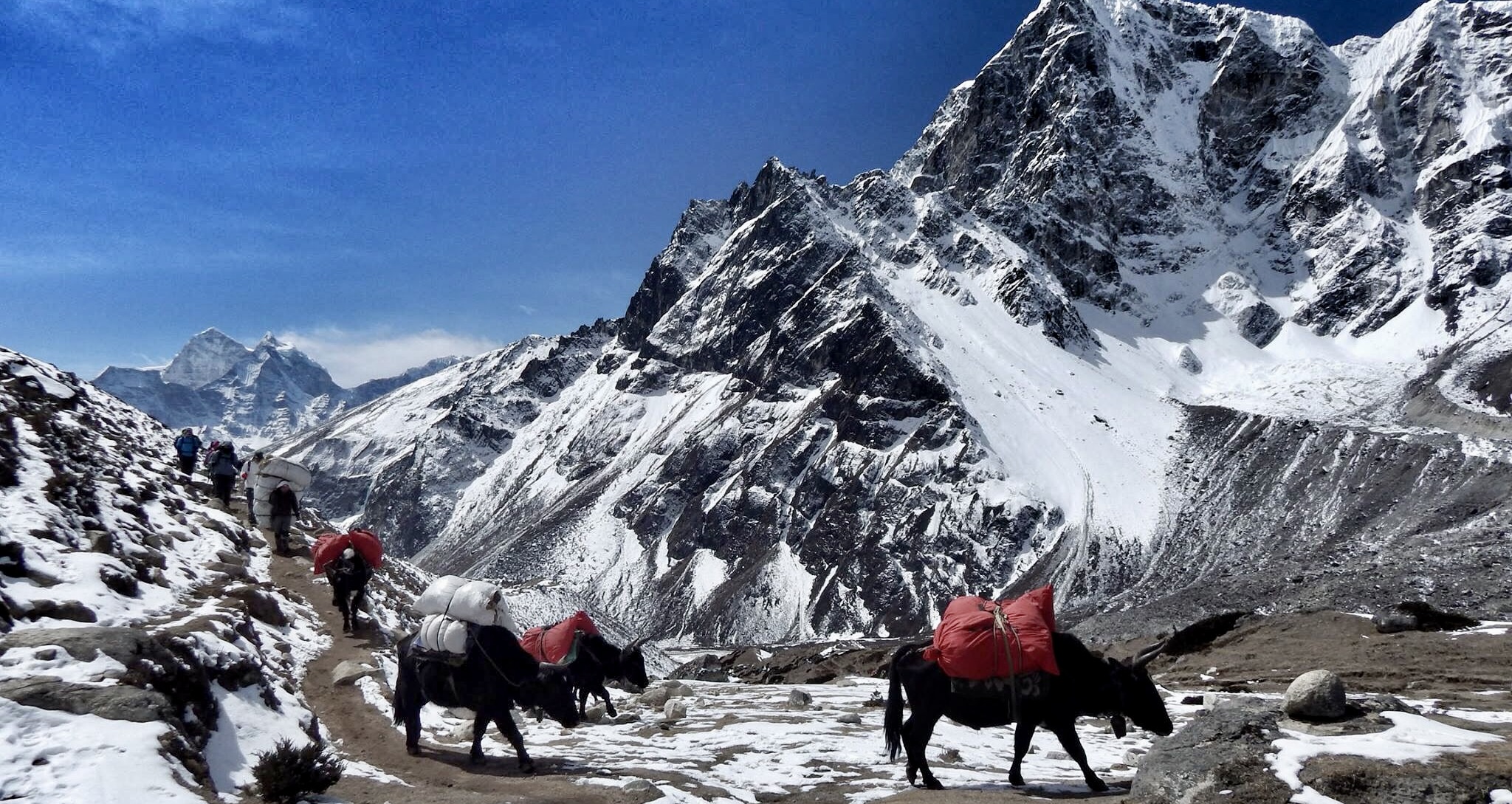
During this time, the skies are generally clear, giving trekkers the opportunity to enjoy stunning views of the mountain peaks, including Mount Everest. This period is also characterized by fewer trekkers on the trail, offering a more serene and less crowded trekking experience.
Furthermore, March is a great time to witness the region's unique flora and fauna as the snow melts and flowers begin to bloom. However, be prepared for occasional snowfall, especially at higher altitudes. Ensure to pack layered clothing to stay warm and protect yourself from unpredictable weather.
In summary, if you prefer a tranquil trek with clear views and are prepared to face some chilly weather, March could be a good month for your Everest Base Camp Trek.
April: The Peak of Spring
April is one of the most popular and ideal months to trek to Everest Base Camp. The temperatures are relatively moderate and the weather is generally stable. The average daytime temperature at the base camp during April ranges from -2 to -10 degrees Celsius (28.4 to 14 degrees Fahrenheit). At night, temperatures can drop to around -12 degrees Celsius (10.4 degrees Fahrenheit).
Clear and bright skies are a trademark of this month, which provides stunning and uninterrupted views of the snow-capped Himalayas. The trails are livelier as the trekking season is at its peak, with many mountaineering expeditions heading toward the base camp.
The vibrant rhododendron and other alpine flowers are in full bloom, adding a splash of color to the landscape. April is also a great time for wildlife enthusiasts as various bird species migrate to the region.
While the weather is generally favorable, keep in mind that it can change quickly in the mountains. Be prepared for occasional snowfall and pack accordingly. Overall, with its ideal weather conditions and blooming natural beauty, April offers an excellent trekking experience for Everest Base Camp trekkers.
May: The Last Spring Month
May continues the run of favorable weather for Everest Base Camp treks, being the last spring month before the monsoon season sets in. The temperatures are a bit warmer than in April, with daytime averages at the base camp ranging between -2 to -5 degrees Celsius (28.4 to 23 degrees Fahrenheit). Nighttime temperatures can drop to around -10 degrees Celsius (14 degrees Fahrenheit).
The trails may be less crowded as many mountaineering expeditions will have already left for their summit attempts in April. You may still encounter a fair number of trekkers and climbers.
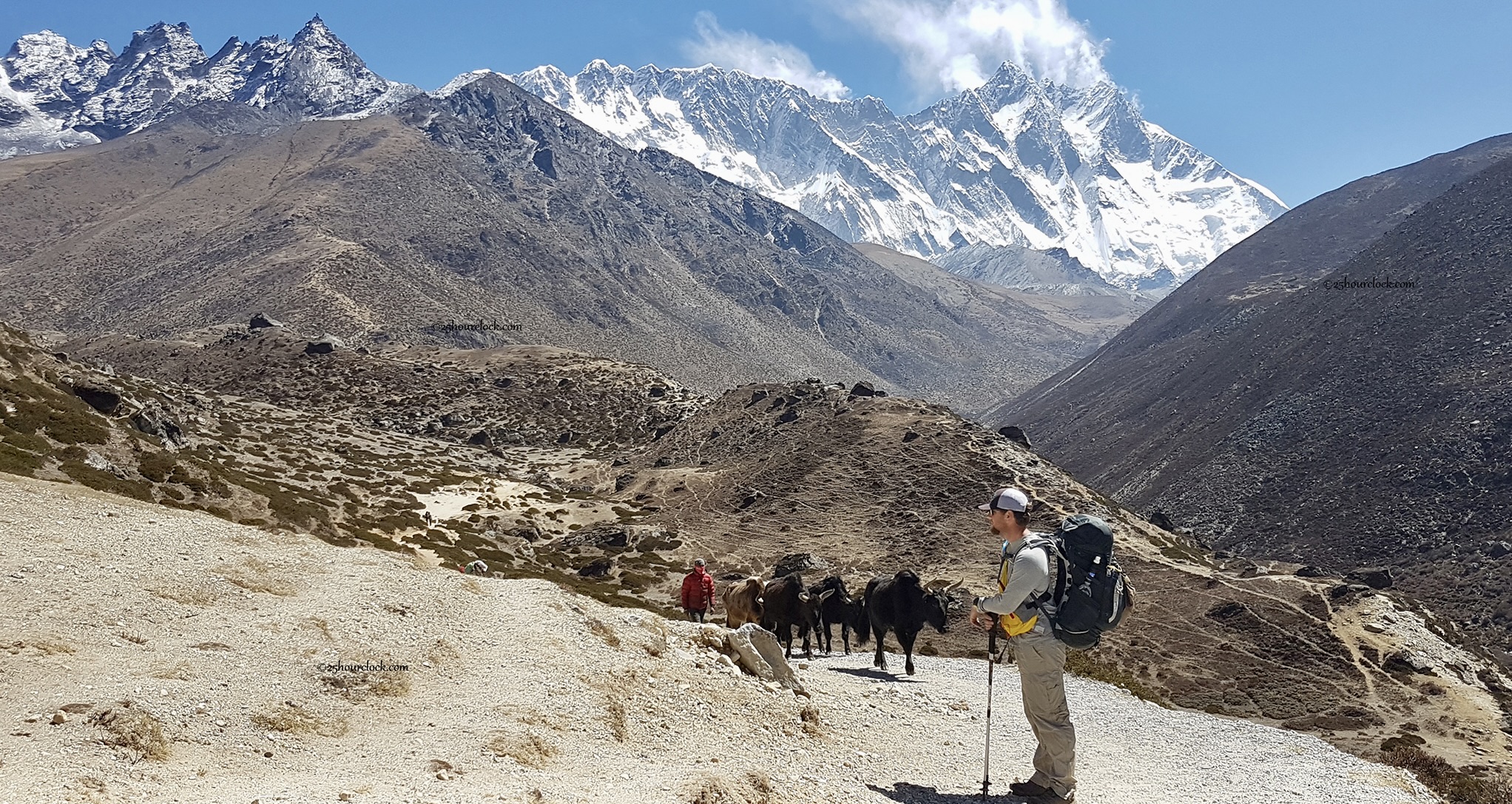
Clear skies are common in the mornings with more cloud cover in the afternoons. The breathtaking panoramic views of the Everest range are still very much on display in May. Wildflowers continue to dot the landscape, and the vibrant Sherpa culture is as enchanting as ever.
Be prepared for sporadic weather changes; despite being generally clear, the chance for snow and rain increases towards the end of May due to the approaching monsoon season. As with any time of year in the Himalayas, it's crucial to pack for a range of conditions and temperatures.
May is a great time to trek to Everest Base Camp with pleasant weather, relatively warm temperatures, and the continued offering of magnificent Himalayan scenery.
June: The Start of the Monsoon Season
June marks the beginning of the monsoon season in Nepal, which can bring unpredictable weather to the Everest region. Daytime temperatures at the base camp average around 2 to -2 degrees Celsius (35.6 to 28.4 degrees Fahrenheit), but they can drop to about -8 degrees Celsius (17.6 degrees Fahrenheit) at night.
Early June can still be a suitable time for trekking, as the full brunt of the monsoon may not have hit the region yet. However, as the month progresses, the likelihood of heavy rain, cloud cover, and poor visibility increases. Trails can become muddy and slippery, making the trek more challenging.
Despite these challenges, there are a few upsides to trekking in June. The trails and teahouses are less crowded, giving you a more solitary experience with nature. Also, the monsoon rain brings freshness to the flora of the region, with lush, verdant landscapes that can be a treat to the eyes.
Given the wet conditions and potential for low clouds and fog, it's crucial to pack waterproof clothing and be prepared for possible delays or itinerary changes due to the weather.
To summarize, while June isn't the peak season for trekking to Everest Base Camp, it can still provide a unique and rewarding experience for the well-prepared trekker who doesn't mind a bit of rain and muddy trails.
July: Peak of Monsoon Season
July is the peak of the monsoon season in Nepal and is often considered the least favorable month for trekking to Everest Base Camp. With average daytime temperatures at the base camp hovering between 2 to -2 degrees Celsius (35.6 to 28.4 degrees Fahrenheit) and nighttime temperatures dropping to -8 degrees Celsius (17.6 degrees Fahrenheit), the climate remains cool.
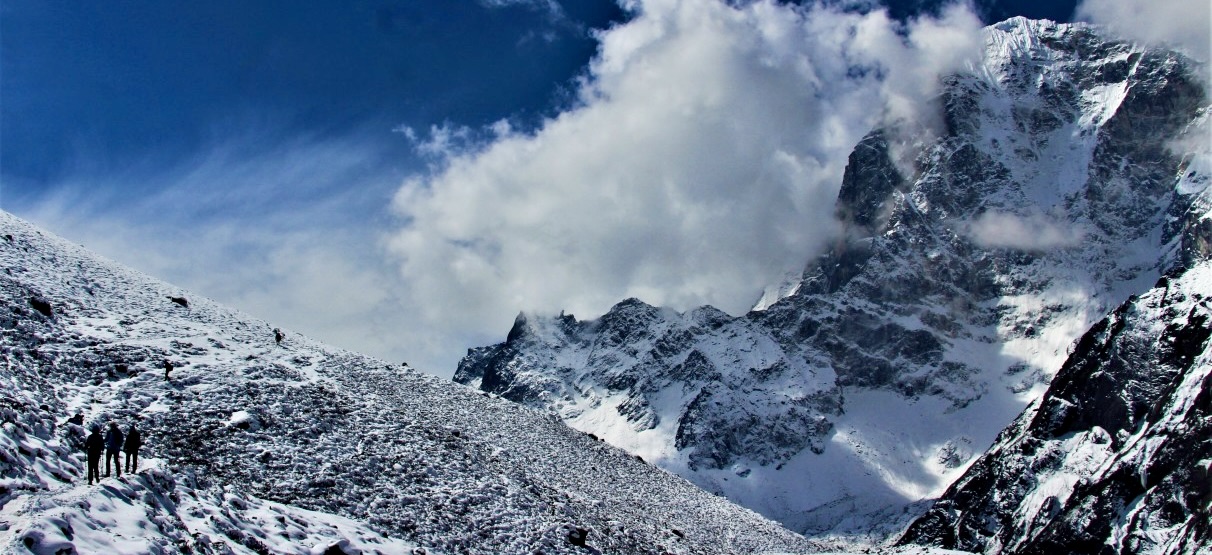
The main challenge in July comes from heavy rainfall, which can lead to slippery trails, landslides, and leeches. Furthermore, visibility is usually poor because of the rain clouds and fog, obscuring the stunning views that trekkers come to see.
Yet, like June, there are a few advantages to trekking in July. The trails are typically empty, providing a quieter, more introspective experience. The rain washes the landscapes, bringing out vibrant colors in the verdant vegetation, flowers, and waterfalls that adorn the trails. The monsoon also brings a sense of tranquility and calm to the mountains, which some trekkers find appealing.
Nonetheless, anyone planning to trek to Everest Base Camp in July must come prepared. Waterproof clothing, good trekking boots, and leech protection are essential. Furthermore, flexibility is key, as weather conditions may require changes in the trekking schedule.
While July is generally considered off-peak for Everest Base Camp trekking due to the monsoon season, it can still offer a unique trekking experience for those who are well-prepared and willing to face the challenges posed by the weather.
August: Transition from Monsoon Season
August is considered a transitional month for trekking in the Everest region as it marks the tail end of the monsoon season. As such, the weather remains unpredictable, with a mix of heavy rains, fog, and occasional clear days.
The average temperature at the base camp during August ranges from 1 to -1 degrees Celsius (33.8 to 30.2 degrees Fahrenheit) during the day, while at night, it can drop to around -7 degrees Celsius (19.4 degrees Fahrenheit). These temperatures are similar to those in July, but with decreased rainfall as the month progresses, the conditions become more favorable for trekking.
Despite the remaining challenges posed by the monsoon season, such as possible landslides and slippery trails, August begins to see more trekkers returning to the Everest trails. The landscapes are still lush and vibrant, washed clean by the monsoon rains, and the mountain views can be spectacular on clear days.
Trekking in August still requires a higher level of preparedness compared to the peak seasons. Waterproof gear, sturdy trekking boots, and warm clothing for cool temperatures are essential. Trekkers must also be flexible and ready for potential changes in their itinerary due to weather conditions.
By the end of August, the monsoon starts to retreat, and the post-monsoon or autumn season begins, which is considered one of the best times for trekking in the Everest region. Thus, those who choose to trek in August may experience the best of both worlds - the lush landscapes of the monsoon season and the clear skies of the autumn season.
September: Beginning of the Peak Season
September marks the beginning of the autumn season, which is one of the most popular times to embark on the Everest Base Camp trek. The monsoon season typically ends in early September, and the weather becomes more stable as the month progresses.
During September, the temperatures at the base camp range from 10 to 15 degrees Celsius (50 to 59 degrees Fahrenheit) during the day, and can drop to between -1 to -5 degrees Celsius (30.2 to 23 degrees Fahrenheit) at night. The first half of the month might still witness some leftover rain from the monsoon season, but these gradually decrease, and by the end of the month, the skies are usually clear.
One of the main advantages of trekking in September is the spectacular visibility. The monsoon rains wash away the dust and pollution, resulting in crystal-clear skies and excellent mountain views. The valleys are also lush and green, filled with blooming flowers.
However, September also marks the start of the peak trekking season, which means the trails can get quite busy. It is advisable to book your accommodations and flights well in advance. Also, remember to pack layers of clothing to adjust to the fluctuating temperatures and a sturdy pair of trekking boots for the trail. Despite the crowds, the incredible weather and stunning views make September a fantastic time for the Everest Base Camp trek.
October: Peak of the Peak Season
October is perhaps the most popular month for the Everest Base Camp trek and is often considered the best time to make the journey. The weather is stable, with little to no rain, clear skies, and moderate temperatures, making it perfect for trekking.
During October, daytime temperatures at the base camp can vary between 12 to 16 degrees Celsius (53.6 to 60.8 degrees Fahrenheit), and the night temperatures can drop to -6 to -10 degrees Celsius (21.2 to 14 degrees Fahrenheit). The lower regions of the trek will be much warmer, so it is essential to pack layers that can be adjusted accordingly.

The primary reason for October's popularity is the excellent weather and almost guaranteed spectacular views of Mount Everest and the surrounding peaks. The sky remains clear, offering breathtaking views almost every day. However, due to the stable weather conditions and high visibility, the trails can get quite crowded during this month.
Despite the crowds, October's comfortable temperatures, reduced chance of flight cancellations due to weather, and excellent mountain visibility make it one of the best months for the Everest Base Camp trek. As always, it's wise to book your accommodation and flights early due to the high demand in this peak season.
November: Early Winter
November sees the start of winter in the Everest region, but it's still a good time to trek to Everest Base Camp, especially in the early part of the month. The weather is still fairly stable, the skies are clear, and the trails are less crowded as the peak season of October ends.
Daytime temperatures in the early part of November range between 6 to 10 degrees Celsius (42.8 to 50 degrees Fahrenheit) at the base camp. At night, it can drop to -10 to -14 degrees Celsius (14 to 6.8 degrees Fahrenheit). Lower elevations will be warmer, but as you ascend, the temperatures will drop, and you will experience a chill in the air, especially during the mornings and evenings.
The clear skies of November offer stunning views of the mountains, with the snowy peaks appearing even more striking against the blue skies. As the month progresses, it may start to snow, particularly at higher altitudes, adding a beautiful white blanket to the landscape.
Since the crowds from the peak season have dispersed, you'll have more tranquility on the trails. It's also easier to secure bookings for teahouses and flights. However, as the month ends, the temperatures continue to drop, making trekking more challenging, so it's crucial to pack warm clothing and be prepared for colder conditions. Always check the weather forecast and consult with your guide or trekking company before setting off.
December: Deep Winter
December marks the arrival of deep winter in the Everest region. Despite the challenging weather conditions, it is still possible for seasoned trekkers to make the journey to Everest Base Camp.
In December, daytime temperatures at Everest Base Camp typically hover around -5 to 5 degrees Celsius (23 to 41 degrees Fahrenheit). However, nighttime temperatures can plunge to -15 to -20 degrees Celsius (-5 to -4 degrees Fahrenheit). The further you climb, the colder it gets, so it's crucial to pack accordingly.
Snowfall is also common during December, which can add a layer of complexity to your trek. Trails can be snow-covered, and in some cases, passes may be closed due to heavy snowfall. However, the snow also brings a serene beauty to the landscape, covering the mountains and valleys in a stunning blanket of white.
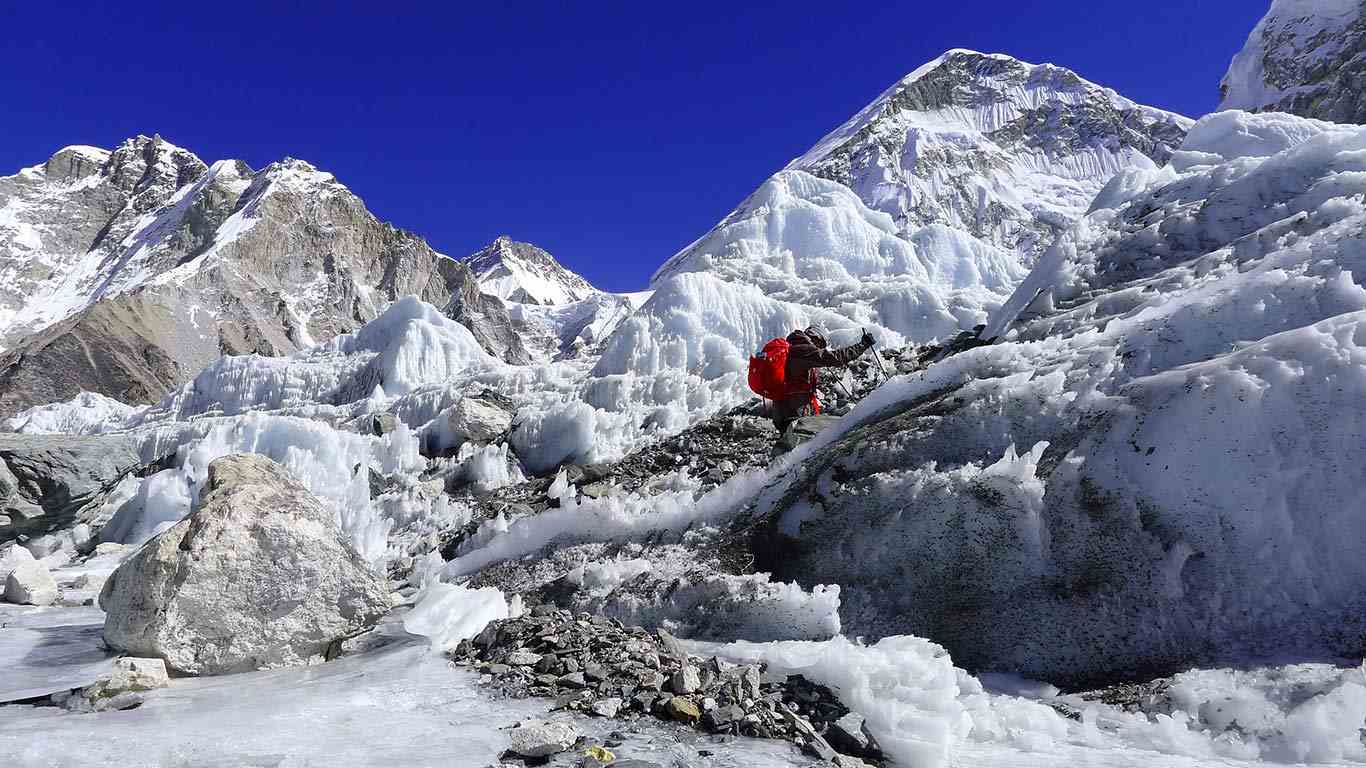
Despite the harsh conditions, the clear skies provide some of the best mountain views you'll see all year. The crowds are also significantly thinner, providing a more solitary and tranquil trekking experience. Teahouses remain open, but services might be limited, so it's advisable to check with your trekking company or guide about accommodation availability.
Trekking to Everest Base Camp in December is challenging, but with the right preparation and mindset, it can be a rewarding experience. You'll need to be physically fit and adequately prepared for extreme cold. It's also essential to have a seasoned guide and to keep an eye on the weather forecasts for any sudden changes. Remember, safety should always be your top priority.
Everest Base Camp Trek - Temperature - month-wise
January: During the day, temperatures usually range between -20°C to -10°C ( -4°F to 14°F). At night, temperatures can drop to around -25°C (-13°F) or even lower.
February: Daytime temperatures generally range between -15°C to -5°C (5°F to 23°F). At night, temperatures can drop to around -20°C (-4°F).
March: Daytime temperatures usually range between -10°C to 0°C (14°F to 32°F). At night, temperatures can drop to around -15°C (5°F).
April: Daytime temperatures typically range between -5°C to 5°C (23°F to 41°F). At night, temperatures can drop to around -10°C (14°F).
May: Daytime temperatures can range between 0°C to 10°C (32°F to 50°F). At night, temperatures can drop to around -5°C (23°F).
June: Daytime temperatures generally range between 5°C to 15°C (41°F to 59°F). At night, temperatures can drop to around 0°C (32°F).
July: Daytime temperatures usually range between 10°C to 20°C (50°F to 68°F). At night, temperatures can drop to around 5°C (41°F).
August: Daytime temperatures typically range between 10°C to 20°C (50°F to 68°F). At night, temperatures can drop to around 5°C (41°F).
September: Daytime temperatures usually range between 5°C to 15°C (41°F to 59°F). At night, temperatures can drop to around 0°C (32°F).
October: Daytime temperatures typically range between -5°C to 5°C (23°F to 41°F). At night, temperatures can drop to around -10°C (14°F).
November: Daytime temperatures generally range between -10°C to 0°C (14°F to 32°F). At night, temperatures can drop to around -15°C (5°F).
December: Daytime temperatures usually range between -20°C to -10°C (-4°F to 14°F). At night, temperatures can drop to around -25°C (-13°F) or even lower.
Everest Base Camp Trek - Air Pressure - month-wise
The air pressure at Everest Base Camp (5300m) remains fairly constant throughout the year. However, the way the human body perceives the pressure, or the 'effective altitude', changes with the weather. This is because cold, dry air seems thinner than warm, humid air.
On average, the barometric pressure at Everest Base Camp is about half that at sea level, or around 500 hPa (hectopascals). This is due to the fact that there is simply less air above you pressing down. Keep in mind that the higher you go, the more the pressure drops.
Here is an approximate guide for effective altitude throughout the year:
January - February (winter): The air tends to be dry and cold, which can make the effective altitude seem higher than it is. You may perceive the air pressure as equivalent to an altitude of 5500m or higher.
March-May (spring): This is a popular time for trekking, with generally warmer and moister air than in winter. The effective altitude might feel like 5300m or slightly less.
June - August (monsoon): The weather is warmer and the air is often moist. However, cloudy weather can interfere with acclimatization. The effective altitude might fluctuate a lot depending on weather conditions.
September - November (autumn): Another popular trekking season with relatively stable and dry weather. The effective altitude would likely feel around 5300m.
December: With winter setting in, the air becomes colder and drier, which could make the effective altitude seem higher, similar to January and February.
These are rough estimates and individual responses to altitude can vary greatly. Additionally, sudden weather changes can influence effective altitude perception. Always prioritize acclimatization and listen to your body when trekking at high altitudes.
Everest Base Camp Trek - Monsoon Measurement - month-wise
While exact measurements can vary from year to year and between different locations along the Everest Base Camp trek, here's a rough estimate of the average monthly rainfall, which peaks during the monsoon season:
January: This is the winter season, with relatively little rainfall, typically less than 20 mm.
February: As we get closer to spring, the rainfall is still on the lower side, generally less than 30 mm.
March: March sees a slight increase in rainfall, with averages around 30 to 40 mm.
April: With the approach of the pre-monsoon season, rainfall increases, with averages around 50 to 60 mm.
May: The pre-monsoon season sees more rainfall, typically around 60 to 70 mm.
June: This is the start of the monsoon season, with heavy rainfall, often exceeding 140 mm.
July: This is the peak of the monsoon season, with the highest rainfall of the year, often exceeding 200 mm.
August: The monsoon season continues with heavy rainfall, often around 180-200 mm.
September: The rainfall starts to decrease as the monsoon season ends, with averages around 100 to 120 mm.
October: With the return of the post-monsoon season, rainfall drops significantly to around 60 mm.
November: November sees low rainfall, similar to early in the year, typically around 20 mm.
December: This is another dry month with minimal rainfall, typically less than 20 mm.
These figures are estimates and can vary. The monsoon season, in particular, can see significant variations in rainfall. Always check local weather forecasts for the most accurate and up-to-date information. It's important to note that during the monsoon season, the trails can be slippery and views may be obscured by cloud cover, but the scenery can also be exceptionally lush and beautiful.
Luxury Everest Base Camp Trek - Weather and Temperature
The weather and temperature during the Luxury Everest Base Camp Trek vary depending on the time of year. The beauty of choosing a luxury trek is that regardless of the outside conditions, you'll have comfortable and warm accommodations waiting for you at the end of each trekking day.
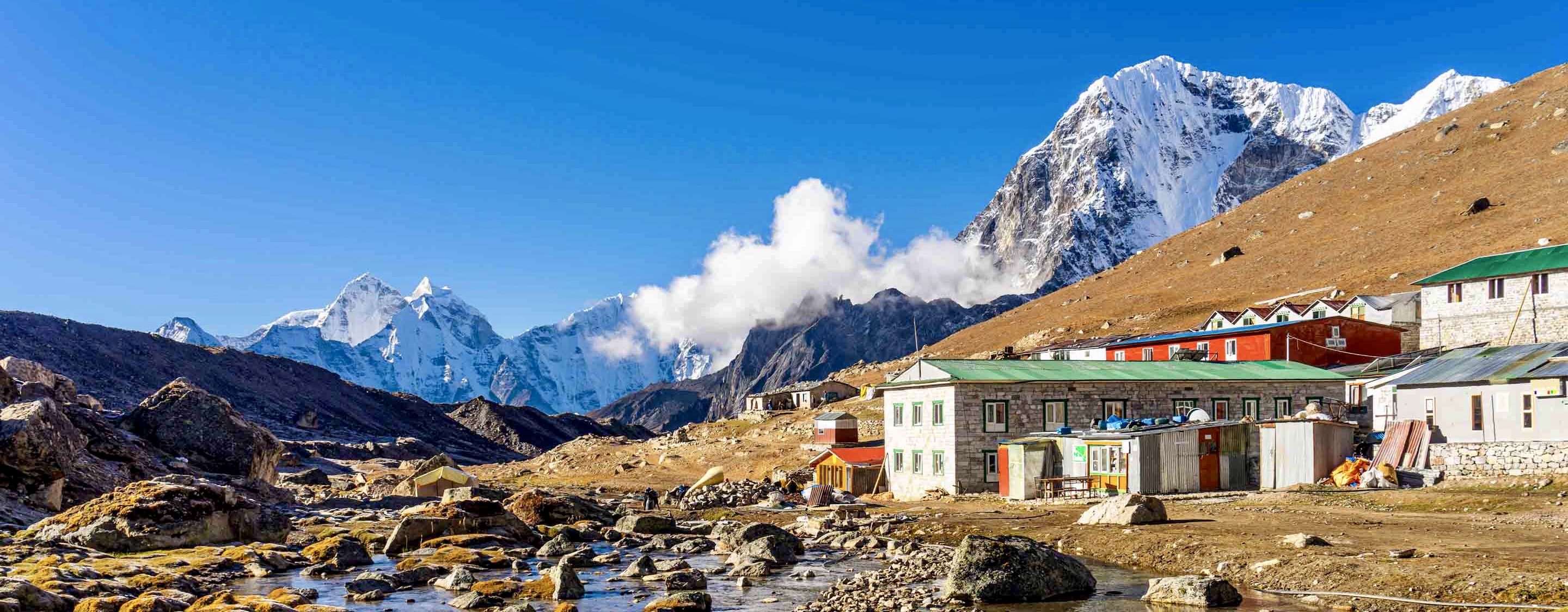
January and February: These are the coldest months, with daytime temperatures around -15°C to -10°C. Nighttime temperatures can drop to -25°C. Despite the cold, the skies are usually very clear, with very few trekkers on the trail.
March and April: The weather starts to warm up with temperatures during the day around 5°C to 12°C. At night, the temperatures can drop to -8°C. The weather is usually clear, making it a popular time for trekking.
May: This month sees warmer daytime temperatures, usually between 5°C to 15°C, with clear and sunny weather. At night, the temperatures can drop to -4°C. This is a popular time for trekking due to good visibility.
June to August: These are the monsoon months, with higher chances of rain and cloudy skies. Temperatures during the day range between 10°C to 15°C, and at night it can drop to 2°C. Despite the rain, some trekkers still prefer this season due to fewer crowds.
September to November: These are the post-monsoon months with clear skies and dry weather. The daytime temperatures range between 10°C to 15°C, and at night it can drop to -5°C. This is one of the most popular times to trek due to the excellent weather conditions.
December: This is the beginning of winter, with colder temperatures ranging between -10°C to 5°C during the day and dropping to -20°C at night. The skies are clear, but there are very few trekkers due to the cold.
Always remember that the weather in the Himalayas can be unpredictable, so it's essential to come prepared with appropriate clothing for cold, heat, rain, and wind. In a luxury trek, you'll be well taken care of with hot meals and comfortable accommodations, making the weather an exciting part of the adventure rather than a challenge.
Everest Base Camp Helicopter Trek - Weather and Temperature
Experiencing the Everest Base Camp Helicopter Trek is an exhilarating journey, offering the breathtaking beauty of the Himalayas in a condensed time frame. While the trekking portion follows the same weather patterns as the traditional Everest Base Camp trek, the helicopter return adds an extra element of weather consideration.
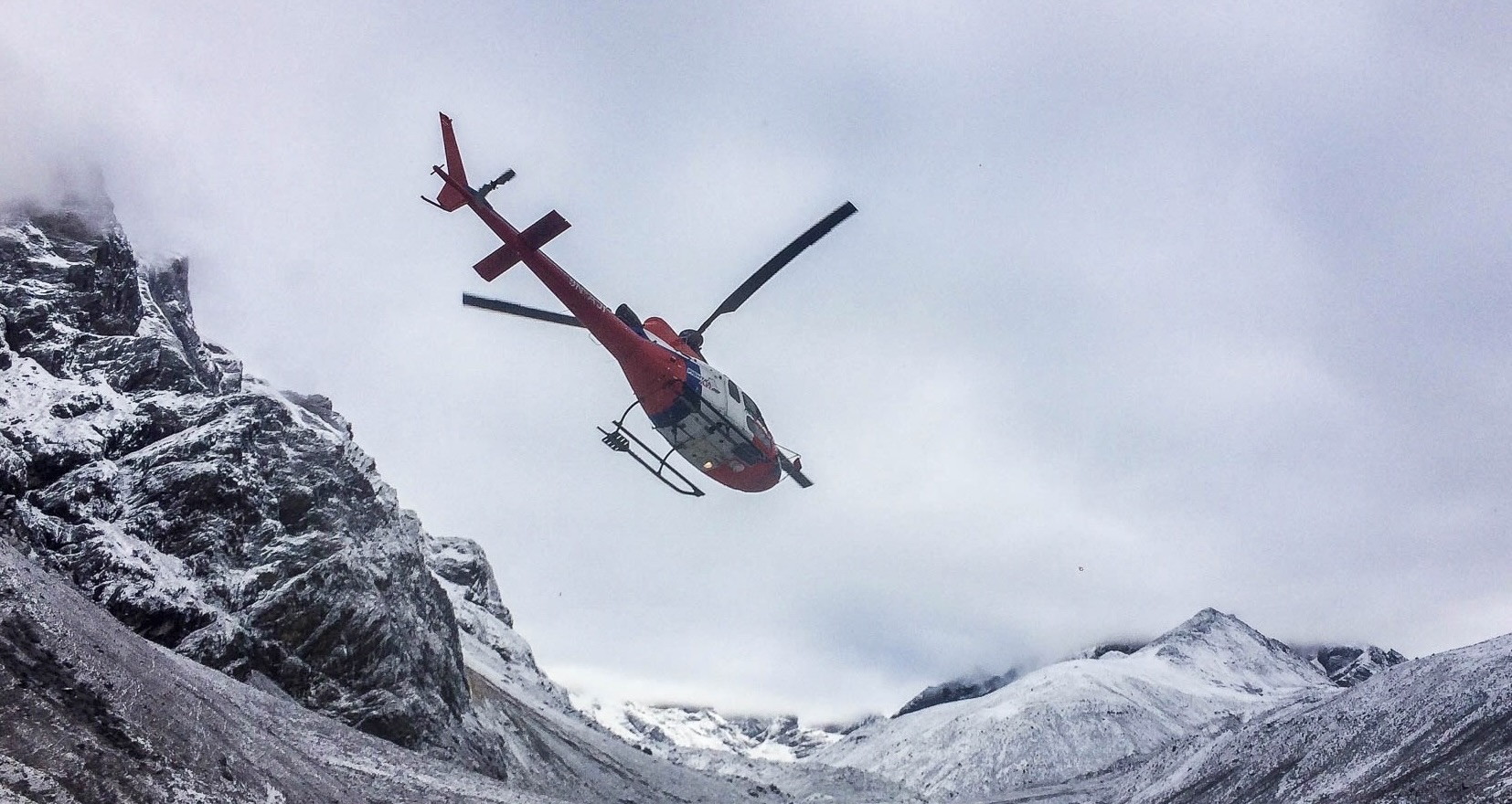
January and February: These months are the coldest, with daytime temperatures reaching -10°C to -15°C, and can drop down to -25°C at night. The skies are usually clear, which is beneficial for helicopter flights.
March and April: The weather starts to warm up, with temperatures ranging from 5°C to 12°C during the day. Nighttime temperatures can still dip to -8°C. The weather is generally clear, which is excellent for helicopter flights.
May: Daytime temperatures warm up to 5°C to 15°C. The weather is generally clear, allowing for excellent visibility for your helicopter ride. At night, the temperatures can still drop to -4°C.
June to August: These are the monsoon months. Temperatures range between 10°C to 15°C during the day and drop to around 2°C at night. The flights are subjected to the day's weather conditions, which could potentially lead to delays or cancellations due to safety reasons.
September to November: These months offer the best weather conditions. The daytime temperatures range between 10°C to 15°C, and at night it can drop to -5°C. The weather is generally clear, making it ideal for helicopter flights.
December: The beginning of winter sees colder temperatures ranging between -10°C to 5°C during the day and dropping to -20°C at night. The skies are clear, but the cold weather can be challenging for some.
The helicopter portion of the trek requires clear and calm weather for safety reasons. Therefore, while the trek can be completed year-round, the best months for the Everest Base Camp Helicopter Trek are pre-monsoon (February-May) and post-monsoon (September-November). However, regardless of when you go, experiencing Everest from the unique vantage point of a helicopter is an adventure that is sure to leave you with lasting memories.
The weather and temperature during your Everest Base Camp trek will vary significantly depending on the month you choose for the expedition. From the crisp, clear skies of the post-monsoon period to the fresh, verdant landscapes of the pre-monsoon season, every month offers a unique perspective on this journey of a lifetime.
It's essential to be adequately prepared for the weather conditions you are likely to encounter. As such, having a comprehensive understanding of the month-wise weather and temperature on the trek can help you make informed decisions about the best time to go, what to pack, and how to prepare. Remember, regardless of the month, the Everest Base Camp trek is an adventure that promises awe-inspiring vistas and the thrill of a lifetime. Here's to your journey to the base of the highest peak on Earth!
FAQs Everest Base Camp Trek Month Wise: Weather and Temperature
Q: What is the best month to trek to Everest Base Camp?
A: The best months to trek to Everest Base Camp are typically pre-monsoon (February to May) and post-monsoon (late September to December) when the skies are clear and temperatures are relatively mild.
Q: Is it possible to trek to Everest Base Camp in winter?
A: Yes, it is possible, but it is more challenging due to colder temperatures and potentially snowy conditions. Fewer trekkers choose this time, so the trail is less crowded.
Q: How cold does it get at Everest Base Camp?
A: Temperatures at Everest Base Camp can drop below -20°C in winter months (December to February). During the trekking season (March to May and September to November), nighttime temperatures can still drop below freezing.
Q: Does it rain a lot during the monsoon season on the Everest Base Camp trek?
A: Yes, the monsoon season (June to early September) can bring heavy rainfall and cloud cover, making the trek more challenging and views less predictable.
Q: What is the temperature like at Everest Base Camp in April?
A: In April, the day temperatures at Everest Base Camp can range from 0°C to 5°C. Night temperatures can drop to -10°C.
Q: Is it safe to trek to Everest Base Camp during the monsoon season?
A: While it's possible to trek during the monsoon season, it's less than ideal due to heavy rain, potential flight delays, and less visibility. It's generally recommended to trek outside of these months.
Q: How quickly do weather conditions change on the Everest Base Camp Trek?
A: Weather conditions in the Everest region can change rapidly due to its high altitude and mountainous terrain. It's not uncommon to experience sunshine, rain, and snow all in a single day.
Q: What clothing should I pack for the Everest Base Camp Trek, considering the weather and temperature changes?
A: Layering is key for the Everest Base Camp trek. Ensure you have thermal base layers, a down jacket, trekking shirts and trousers, a waterproof jacket and trousers, good quality trekking boots, warm gloves, and a beanie.
Q: Do all tea houses on the Everest Base Camp trail have heating?
A: Most tea houses will have a communal area with a stove for heating but bedrooms are usually not heated. It can be very cold at night so a good quality sleeping bag is essential.
Q: How can I prepare for trekking in cold conditions on Everest Base Camp Trek?
A: You can prepare by investing in good quality, warm clothing, and ensuring that you have a sufficient level of fitness. Additionally, it's crucial to understand your body's response to cold and be aware of signs of hypothermia. A positive mindset is also a valuable tool.
Everest Region Trekking Packages
Everest Heli Trek with Kalapathher Landing
Gokyo Lakes and Everest Base Camp Trek
Everest Base Camp Heli Trek - 9 Days
VVIP Everest Base Camp Luxury Trek
Everest Base Camp and Gokyo Lakes Luxury Helicopter Trek
Luxury Everest Base Camp Trek - 14 Days
If you need any further information, please contact us by email: at [email protected], Phone: at +977- 985 100 5129 (WhatsApp)




